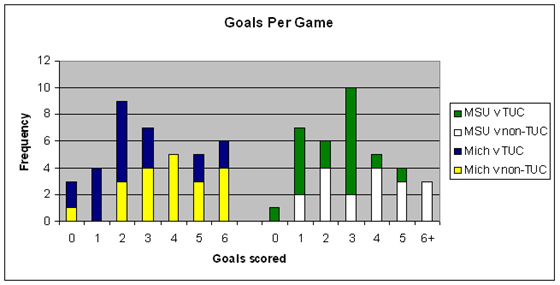Puck Preview: Michigan State, CCHA Quarters

| WHAT | Michigan @ Michigan State CCHA Second Round |
|---|---|
| WHERE | East Lansing, Michigan |
| WHEN | 7:05PM EST March 12th/13th, 2010 If necessary: 7:05 PM EST March 14th |
| THE LINE | College hockey lines, junkie? |
| TELEVISION | Friday & Saturday: Comcast Local |
Michigan State
Record. I'm pretty sure that frequent commenter Spartan Dan put together a killer weekend preview at The Only Colors simply to shame me—it's even got this site's usual "you want this WCHA series to go this way because of the marginal effect it will have on our pairwise comparisons" section—and shame me it has done. It has also done a significant amount of the legwork, though, so we'll call it even.
Anyway: 19-11-6, 14-8-6 CCHA. Second place. Goal differential of +0.67 per game overall and +0.32 in conference. Bizarrely, Michigan's goal differential is considerably better in both instances (+0.85 and +0.5, respectively) despite being the seventh seed here. What's going on? Dan has a great chart that helps explain things:
 Right away you can see more spread in Michigan's goal results. State scores three a lot, zero almost never, and six relatively rarely. Their goal curve somewhat approximates a normal distribution. Michigan has nights of wild success and nights like… well, you could name a dozen at this point. This dovetails nicely with a post I threw on mgolicious recently about a new method for reducing the error in baseball's Pythagoran prediction schemes*. It's kind of obvious:
Right away you can see more spread in Michigan's goal results. State scores three a lot, zero almost never, and six relatively rarely. Their goal curve somewhat approximates a normal distribution. Michigan has nights of wild success and nights like… well, you could name a dozen at this point. This dovetails nicely with a post I threw on mgolicious recently about a new method for reducing the error in baseball's Pythagoran prediction schemes*. It's kind of obvious:
Your actual win total doesn't just depend on runs scored and allowed -- it also depends on the consistency of each. If your scoring is less consistent than average, you should outperform [ed: I don't think this is good phrasing.] Pythagoras in terms of wins. For instance, if you score exactly the same number of runs as you allow, you should wind up a .500 team. But if you win more blowouts than average -- by scores of 15-2 and 16-6, for instance -- you'll finish at less than .500, because you've "wasted" your runs when you don't need them. And if you *lose* more blowouts than average, you'll win *more* games than 50 percent, because your opponents are "wasting" their runs.
A team that scores zero goals half the time and eight goals the rest of the time is going have the best goal differential in the world and be .500.
it's a little tough to parse this pattern out, but try to just consider the TUC games (blue and green). There the pattern is even more stark: State still scores three a ton, with one the next most popular and some other scattered numbers. Michigan's mode is two—ick—and the goal scoring is much more distributed. TUC teams are the top half of the schedule and more likely to score goals against you: here is the gap between Michigan's goal differential and its record.
Is this luck or something wrong with the team? Dan makes a case for the latter based on Michigan's style of offense this year ("chuck it at the net and see what happens") and I agree with him. The posterboy for this effect is Louie Caporusso, who has been on a tear of late against iffy goaltending and poor defensive teams but was totally stymied against the meat of the schedule. Michigan as a whole seems like TJ Hensick trying to make it in pro hockey: too good for the AHL (usually) but not good enough for the show.
This is a long and complicated way of saying that I wouldn't put as much into the goal differential as you might otherwise. I think it bodes well for Michigan next year, but maybe not this weekend.
*(For those less likely to have a collection of German board games: Bill James took a look at the numbers and found out that run differential was a better predictor of next year's record than last year's record. This finding is generally applicable and definitely applies to hockey. It's a major reason I think the hockey team will bounce back to its usual terrifying self next year. There's no place like home… no place like home… no place…)
Dangermen. Insert default complaint about Corey Tropp… no, insert a new one: it is totally ridiculous that the only punishment Corey Tropp received was missing the remainder of a season in which State had already checked out for good anyway. Michigan State had such deep respect for the idea that Corey Tropp should sit out games that they tried to stash him in the USHL so he wouldn't get rusty and only backed off that plan when someone in compliance said it would affect his eligibility. Rick Comley has permanently lost my respect, and the way this incident has played out makes me long for the day when Michigan can tell the league to GTFO and join a Big Ten hockey conference.
But anyway. Karma is busy with the Spartan football team at the moment and has ignored the above, so Tropp is Michigan State's leading scorer with a 20-22-42 line. Derek Grant has 11-18-31 and Andrew Rowe a 15-11-26, from there there's a significant dropoff. Expect Hagelin to get the Tropp line whenever they can manage it.
Defense and goalie and whatnot. Drew Palmisano has developed into one of the country's best goalies—something you could see coming as he split time with Jeff Lerg last year—and has a .922 save percentage.
Earlier in the year I suggested that Michigan State's extremely young defensive corps might be an exploitable achilles heel, but I just looked at the year next to their name and not their birthdates. None of these guys is straight out of high school and some of them can already drink. (Drink legally, that is. These are hockey players.) "Freshman" Zach Josepher is a few months away from turning 22! So nevermind on that.
The key guy on the Spartan D is Jeff Petry, a second-round pick of the Oilers who had a terrible year last year beyond just having crappy teammates but has bounced back to be both the Spartans' best offensive defenseman—22 assists—and most reliable defender. Josepher and fellow freshman-type object Torey Krug (actually younger than 20) are the next two guys on the depth chart. Krug is a smallish puck mover, Josepher more of a defensive sort.
Michigan, meanwhile, is still rolling out pint-sized walk-on Shawn Hunwick. This is good for the profile-seeking newspaper writers of Southeastern Michigan, but maybe not so good for Michigan's chances this weekend. Both of the goals Lake State scored on Friday were super soft and I'm sure everyone else is as creeped out by how often he jumps at pucks as I am. On the other hand, the two Friday goals were the only on the weekend and Hunwick did make a couple of grade A stops on Saturday to preserve his shutout.
While it's not a foregone conclusion that Hunwick is outperformed, it's pretty likely.
As a bonus, senior captain Chris Summers is out. Lee Moffie draws into the lineup, and this might mean bad things defensively. It just goes to show that I don't know everything (or even much) about hockey that I thought he was killing it when this was going down:
But after he dressed in 13 consecutive games, Moffie was pulled for his defensive lapses. In the final five games of that stretch in late January, Moffie had a plus/minus rating of minus-five. He has played in just four of the last ten games.
“I’ve known from the start that the defense is my thing that will keep me out of the lineup, they made that pretty clear,” Moffie said. “I’m an offensive defenseman, if I’m not producing and I’m out there for goals, I’m not really worth a lot to this team.”
His defensive issues must be a lot more subtle than Llewellyn's tendency to pick up dumb penalties and get caught up ice.
Special teams. Your power plays per game stat:
| MSU | Michigan | |
|---|---|---|
| PP For / G | 5.6 | 5.7 |
| PP Ag / G | 5.1 | 5.4 |
Michigan's specialty units are more effective than State's. Michigan's penalty kill is borking along at a 87.6 rate. Michigan State is in the middle of the pack (20th) at 83.2. On the flip side, neither team is much good on the powerplay. Michigan is 29th, State 34th. That's basically a wash.
Since Michigan State has a better ratio of PPs for and against, this section is basically even.
Michigan Vs Those Guys
Play like an underdog. Michigan's been playing a tighter, simpler game with Hunwick in net and the results have been fewer scary turnovers and few grade A opportunities. Michigan State is a step up from Hunwick's first four games, which were against 9th place Notre Dame and 10th place Lake State and will actually be able to generate scoring chances of their own. Michigan should play a conservative game in the hopes of protecting Hunwick.
Clone Carl Hagelin and put him on three lines.
Figure out why you are so inconsistent, especially against TUC opponents, and fix that season-long issue in a week. What? It could happen.
The Big Picture
The Pairwise still doesn't matter for Michigan. They're 25th right now: it's CCHA championship or bust. That requires winning this weekend and against Miami unless Ohio State pulls off the upset of the year in the CCHA, with Ferris State or Alaska or someone else the last hurdle. The pulse still remains faint.
On the other hand, the Pairwise implications of this series are huge for Michigan State. They sit 12th. With Bemidji State comfortably in the top eight, there is only one auto-bid that is definitely getting handed out. You could get in with a PWR as low as 15, but to be safe you'd like to get to 14 or, better, 13. If Michigan State loses this series they will take two TUC losses against zero or one wins. Depending on the results of other series, this could knock them out of the tournament entirely.
Michigan's playing for its life in this series and doesn't need anything else to motivate, but that's a nice little bonus.

Comments